
The philosophy of Reinhold Messner
Back to the E3/DC booth where mountaineer Reinhold Messner told the gathered start-up entrepreneurs and solar executives: “Before I climb a wall, I develop an idea, find a line. I decide, where are my strengths best used to achieve the goal.”
He added: “Whoever prepares an expedition has to overcome fear with courage but also with good preparation and training until only a residual fear remains.
“But then you have to to decide to stop preparing and start, go out and dare, otherwise the fears will grow again.
“Tackling dreams is a gift! But a castle in the air doesn't take you far.”
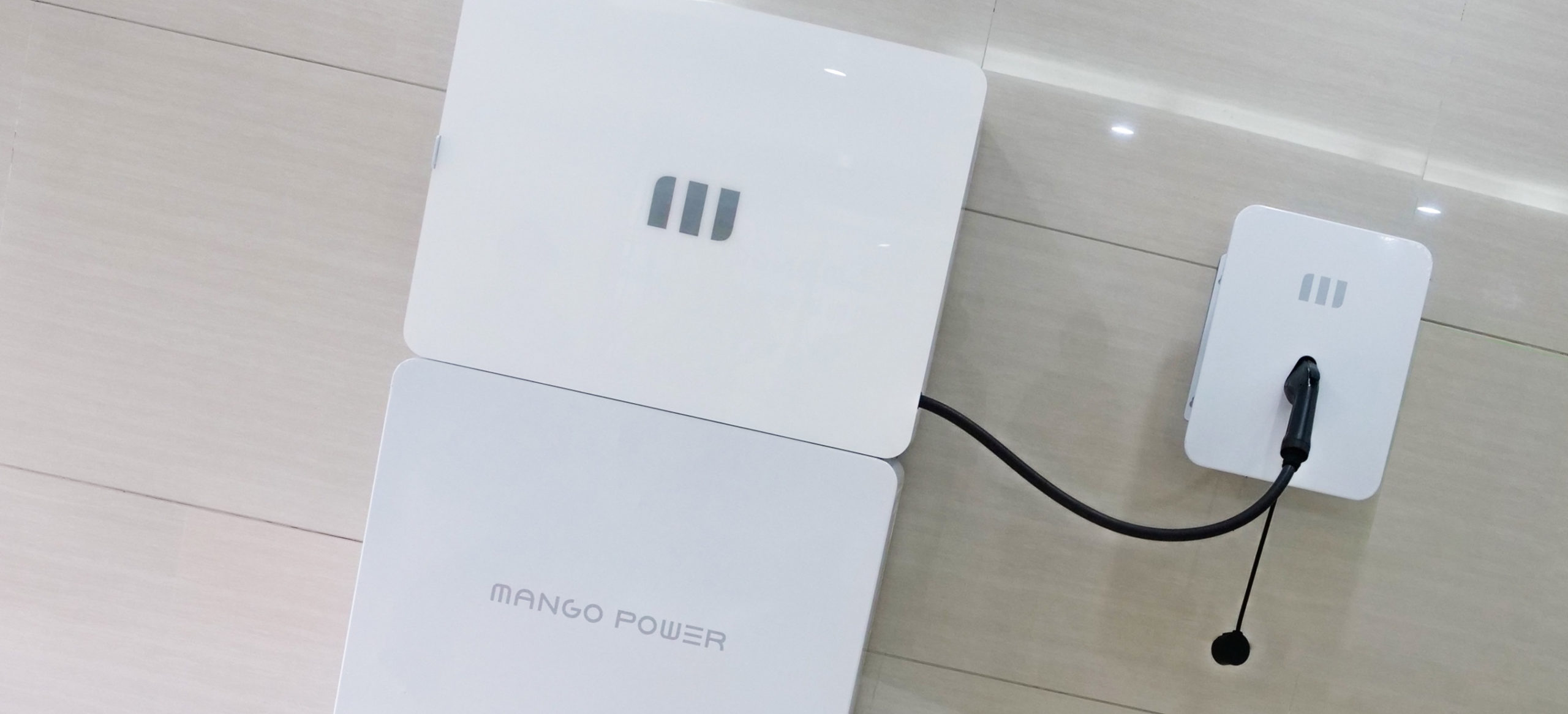
Ripe for the pickin'
Mango Power is back at Intersolar with a new product ready to ripen, called the M Series.
It is described as a first for an all-in-one storage platform for the home: incorporating an inverter, battery storage for home power back-up and gateway, and and electric vehicle charger.
Mango Power has sourced LFP batteries from Catl to keep things fresh and they will be customized for taste in the EU and US markets.
Mango Power told pv magazine that in terms of pricing and availability, the EU-specific model will start at 10 kWh for €9,999 (10,536), with first availability from July.
The best of three worlds
Swiss start-up Hero.wind is taking a new approach to rooftop solar.
Its modules combine photovoltaic, solar thermal, and wind power generation with the 50 cm by 38 cm product featuring 12 half-cut PERC cells.
The start-up rates the PV efficiency of its panel at 20% and it will likely be a bit more, says Korab Shabani, project lead at the business.
The reason for that is active liquid cooling on the back of module that cools the cells. The heat is not wasted as it creates a 45 degree Celsius circuit of warm liquid which can then be used to heat up water for showering or use in radiators.
There are wind channels at the top of the module that lead to small, computer fan-sized rotors. These miniature wind turbines are said to produce 5 watts.
Asked about whole-system efficiency, Shabani said there is no real calculation, yet. But that might follow from two pilot installations, in Switzerland and Germany.
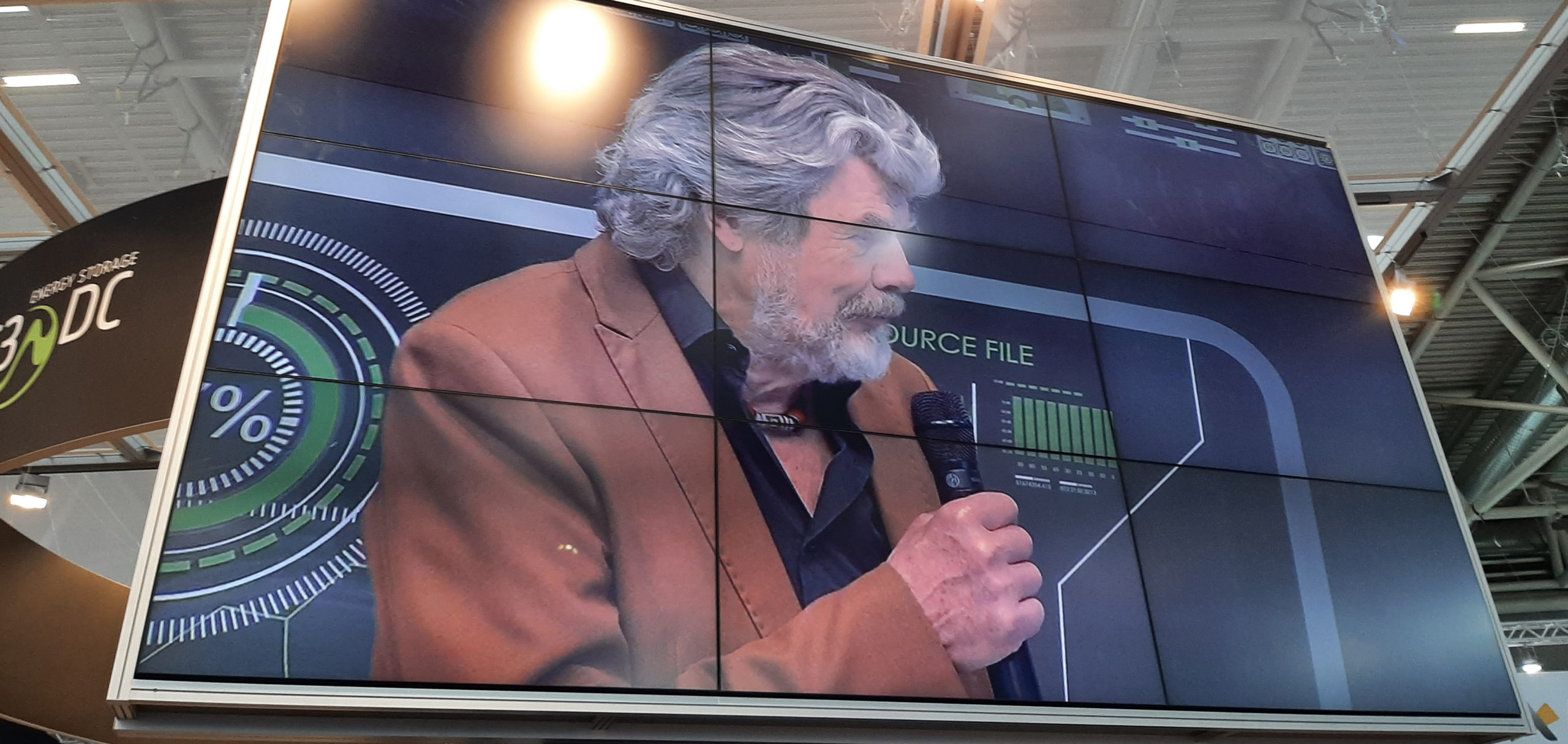
'We have a mountain to climb to beat global warming, you say?'
Beatriz Santos was part of the crowd drawn to hear German superstar Everest climber Reinhold Messner discuss sustainability at the E3/DC booth, where it looks like it's standing room only.

Jenny Chase gives her latest solar predictions
The solar Twitterati have swooped by the pv magazine booth, in the form of pv magazine USA editor John Weaver, AKA Commercial Solar Guy and @SolarInMASS plus solar legend BloombergNEF's Jenny Chase (@solar_chase).
Chase is known both for her adroit insights into the solar industry and her prodigious goose breeding.
While with us today, Chase provided a typically sharp-witted take on this year’s Intersolar. She started on a rather apologetic note, feeling her previous predictions of declining module prices – that have yet to come to fruition – may have played a role in delayed module procurement decisions; although she did admit the industry would have probably waited anyway.
After she leaves Intersolar on the bus back to Switzerland, Chase’s job is to make the end-of-year module price predictions. Will they come down from the current high of $0.262 per Watt to a quarter? Feathers will fly either way.
It appears module buyers have given up expecting prices to come down any time soon and are starting to get back to the business of building projects again. Particularly as developers are keen to lock in financing before central banks raise interest prices further.
Chase observed people appear to be flocking to the German solar market; although in the wider industry there are a lot of delayed projects, particularly those to be developed under tender, which developers will either have to abandon or build at a loss – due to increasing component costs, inflation, and interest rates. According to Chase, African projects in particular, are likely to be worst affected.
This year saw records fly in terms of exports, she said, with China hitting an all-time high of $4.1 billion in March, with India buying the bulk of those products, probably due to a rush to supply the market before the 40% import tariff which took effect at the start of April. From March on, Europe was the recipient, with a record $1.9 billion in exports reaching the EU from China. Chase doesn’t believe that is down the Russia-Ukraine conflict either.
Dampening the joy, while some European solar manufacturing plans appear to have been fully incubated, Chase does not believe the continent will be successful in re-establishing a strong domestic base; rather a few isolated factories supplying the rooftop market will be the most concrete result, despite all the soaring production announcements.
Before taking flight, Chase said despite all the challenges, the overall mood from those she spoke to was “very excited!”
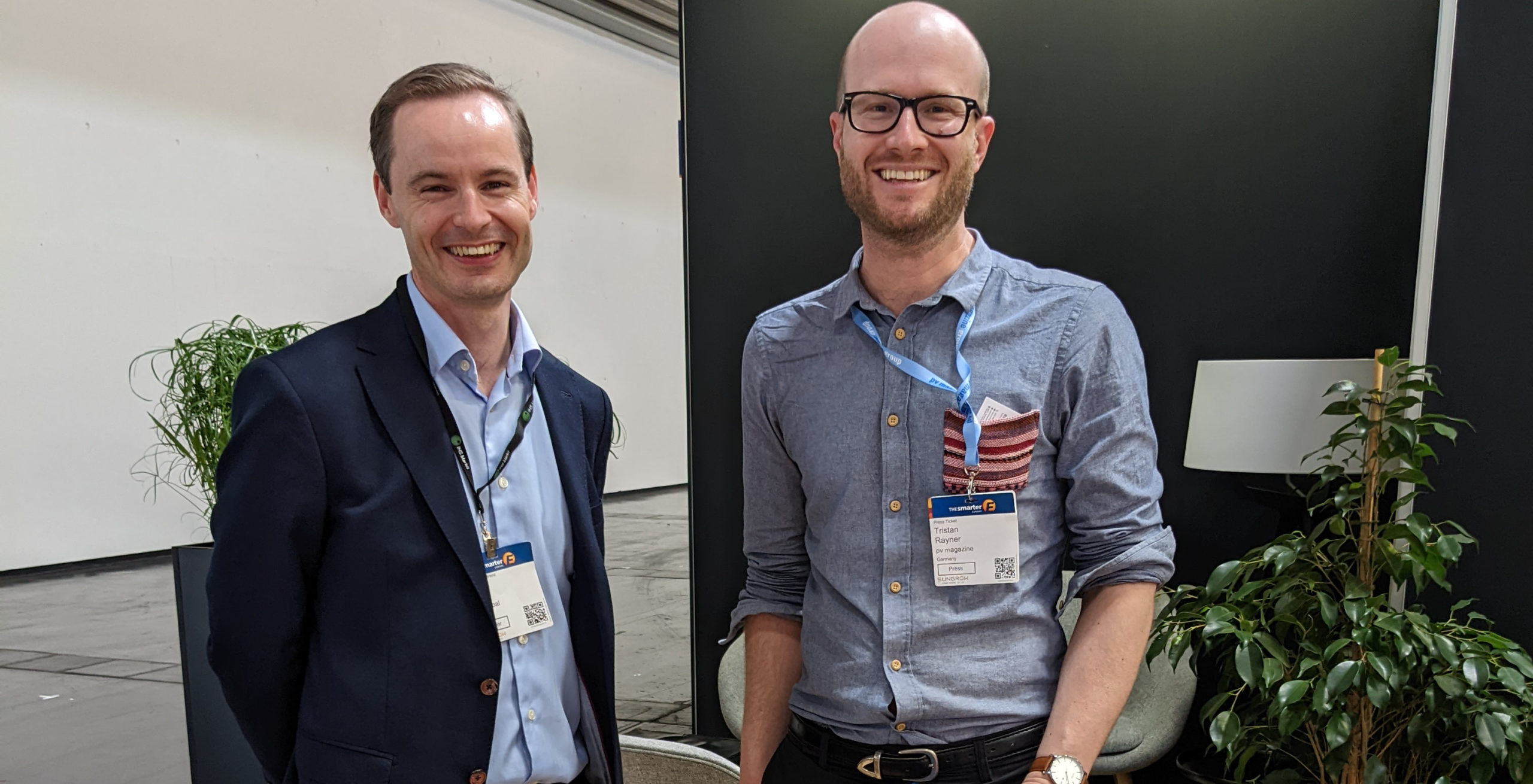
Look who's dropped in!
Solar guru Cormac Gilligan, from S&P Global neé IHS Markit just popped by the pv magazine booth to talk EU manufacturing of inverters and wider balance-of-systems components.
Cormac reckons around a quarter of the inverter market remains in the hands of companies based in Europe.
How have they survived the solarcoaster and what's next? Find out in the June edition of pv magazine…

Mark Hutchins gets to grips with The Laminator
More big production plans: Laminator supplier Robert Bürkle has confirmed to pv magazine it will be supplying the planned 3 GW fab for heterojunction modules which Enel is working to ramp up in Sicily.
And the company has clearly been hard at work on new lamination processes as well, with glass-glass modules thick enough to walk on, and cells laminated between curved glass shapes all on show at its booth.
pv magazine will be taking a closer look at some of those next week, in our virtual spotlight event on Wednesday, May 18, 2022: Click here to register for free.
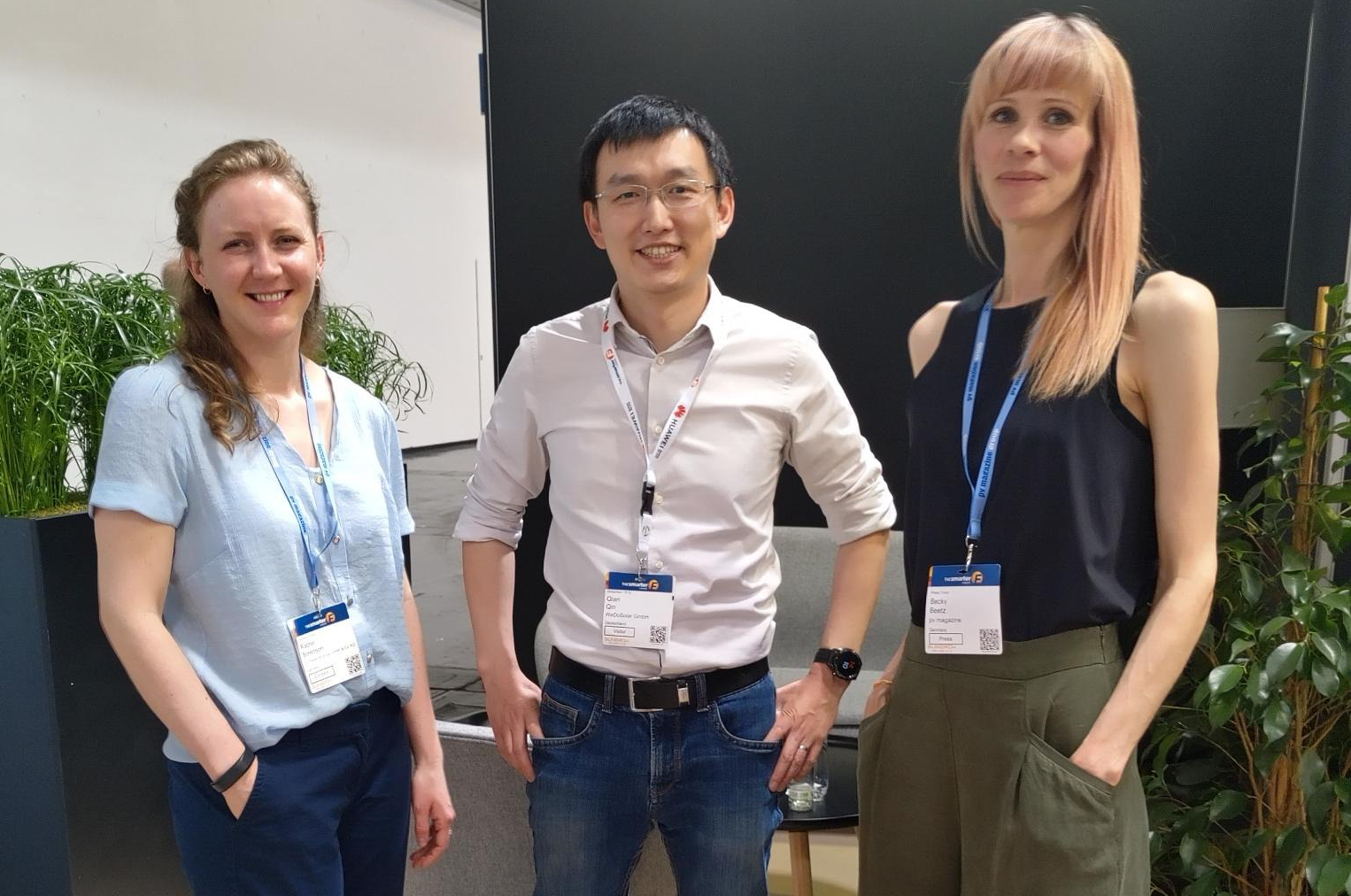
A plug-and-play solar panel you can fit yourself
We Do Solar is the brainchild of Karolina Attspodina and Qian Qin and pv magazine had the pleasure of catching up with Qin at Intersolar to hear about the innovations behind the Berlin start-up, which is gearing up to deliver its first balcony solar modules to customers within three weeks.
Weighing in at a remarkable one kilogram, the product is a sleek, black solar module that can be clipped onto balconies or anywhere else there is sun and a power socket.
Taking the idea of plug-and-play a step further, the kit is designed for anyone to be able to install, without the need for an electrician or engineer.
The innovation is particularly interesting for people who rent or do not have a rooftop since it is also possible to unplug the module when its owner moves home.
There are three We Do Solar business models: You can buy the kit outright for €1,299; if you have an electric vehicle, you can exchange your CO2 certificates for a free kit; or employers can take advantage of an employee benefit program.
Given the made-in-China module’s low weight, it can be shipped as a package and it comes wrapped in paper, rather than plastic.
There are too many other exciting details to go into here, so watch out for a longer article on We Do Solar next week!

The cutting crew
Laser expert 3D-Micromac is confident future cell and module concepts will require even more cutting.
And in Europe, at least, manufacturers seem fairly convinced the company's thermal laser separation process is the best option and a sure way to avoid damage to the edge of cells.
At the 3D-Micromac booth, Thomas Kießling and Katja Fiedler were keen to demonstrate the neat coil their process can cut into a piece of delicate semiconductor-grade silicon.
And on the orders side, they told us to watch this space for a big announcement that will be on the way soon!
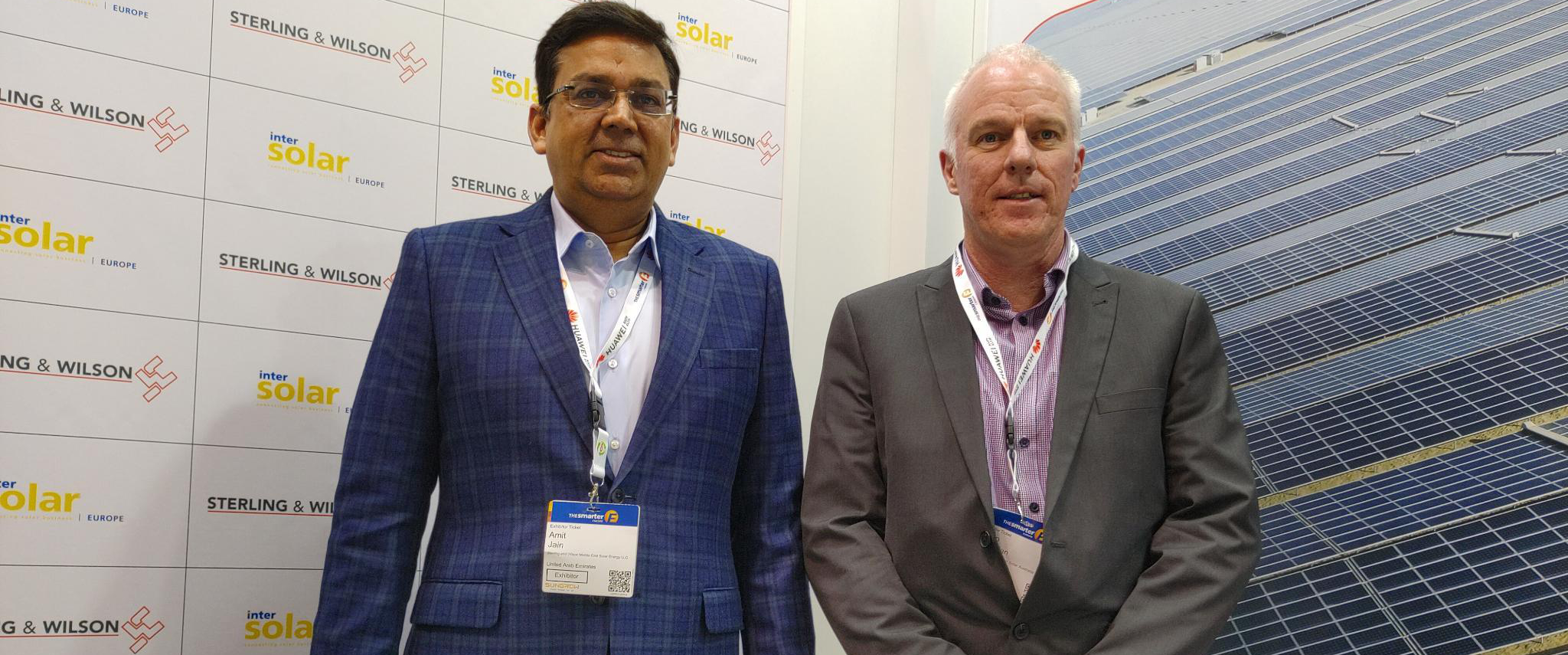
A Reliance on solar giants
As has been widely reported, Indian conglomerate Reliance Industries has been on a solar shopping spree in recent months. One of the beneficiaries was Sterling & Wilson, also based in India, with Reliance taking at 40% stake in the global engineering, procurement and construction services provider.
Sterling & Wilson CEO Amit Jain told pv magazine that with $100 billion in revenues, Reliance is a great partner to have with a global reach and strong financing to help the EPC execute its plans.
The investor will also be able to help supply components along the solar value chain. In India, for example, Reliance has plans to install 100 GW of projects by 2030 and Sterling & Wilson expects to be a “frontrunner” in executing that pipeline.
The developer suffered project delays and a hit to its margins last year thanks to those very supply chain constraints, said Jain, however work is picking up again and many projects are nearing completion.
The CEO believes the next couple of quarters will be more positive and 2023 will see price and supply issues resolved and stability restored.
In other trends, Jain expects to see “solar taking off in a big way” next year and after, with many more projects coupled with hydrogen, particularly in Spain and North Africa. There will also be a shift away from smaller projects to very large scale sites, perhaps in the multi-gigawatt range alongside hydrogen, wind turbines and energy storage.
Having recently opened its first European office, in Spain, Sterling & Wilson is now targeting debut projects this year in Spain, Greece, Portugal, Holland, and Romania. Initially, its pipeline will be between 500 MW and 1 GW, although no concrete details are available as yet.

An eloquent metaphor?
The temperature is rising at the Intersolar show and pv magazine‘s answer to David Attenborough, Tristan Rayner, appears to have found one sad victim.
You recall that proud AE Solar polar bear promoting the company's products yesterday, right?

Iron flow batteries coming to Europe
NYSE-listed iron flow battery specialist ESS is expanding into Europe with its first deployment in Spain already in operation.
A project commissioned by Enel Green Power and coupled with a solar farm, features 17 of ESS' long-duration Warehouse iron flow battery systems with a cumulative capacity of 8 MWh.
As pv magazine passed the company booth, we saw staff talking with another major Spanish utility: Iberdrola. While ESS is clearly negotiating projects and seeing strong demand for its systems in Europe, the company still hasn’t decided where to set up its European headquarters.
European insurance policies, however, are in place. ESS systems are supplied with what the company claims is an industry-unique 10-year warranty through Munich Re for its flow battery technology and electrolyte management system, supporting system performance guarantee regardless of project size or location.
And the company is expanding its US-based production at a fast pace. As Alan Greenshields, ESS director for Europe, the Middle East and Africa told pv magazine, US production capacity stood at 250 MWh last year but is now already topping 2GWh. “The customer interest is massive,” Greenshields said.
ESS iron flow batteries provide 4-12 hours of storage and unlimited cycles with no capacity loss. The product is made using earth-abundant materials such as iron, salt, and water, which makes it low-cost, sustainable, and safe.
And while lithium-ion might have a lower capital cost per kilowatt-hour, ESS' company’s iron flow system can reportedly claim parity at four hours, and win thereafter..
Compared to their technological cousins – vanadium-flow batteries – iron flow claims to win by a large margin. According to Greenshields, the cost of iron-flow stands at around $20/kWh whereas vanadium-flow costs can be as much as $200/kWh.

A big reduction in silver content
M10 this week lifted an Intersolar Award for its ‘shingled matrix’ – surely one of the most innovative new manufacturing solutions on show this year: Cells cut into 5-7 pieces are assembled into the “matrix” – allowing for huge flexibility in module size and shape.
At the company booth, M10’s Marco Saladin told pv magazine the approach makes far more efficient use of the silver-containing glue than other shingled module approaches, using as little as 1 gram per module, a mere 10% of the amount used in a typical shingled module.
M10 has begun manufacturing the machines with joint venture partner Zahoransky, and says it will soon be supplying tools to two customers, one which makes building-integrated PV products and another which produces conventional solar modules.
This year's Intersolar Europe has its mojo back
IHS Markit solar analyst Josefin Berg, an Intersolar veteran, has described the intensity of this year’s show as being back at 2010-levels.
Sitting down with pv magazine for a chat about the market data company’s solar PV market outlook for 2022 and beyond, Berg said “PV in Europe is beginning a strong growth period.”
And that mood has certainly been reflected on the ground here at Intersolar Europe.
Whether manufacturing will return to Europe on a large scale “is the big question,” Berg said.
We’ll have to wait for more details on the European Commission’s REPowerEU policies but the analyst added: “European companies are certainly preparing for it.”
Boom times for solar production equipment suppliers
This week, things are looking particularly rosy for Europe’s factory equipment suppliers, with a few large projects already in the works, and plenty more signalling serious interest! Stand by for more updates from Mark Hutchins in hall A3…
Better tracker control for superior yield
Trina's new control system for trackers, the SuperTrack, promises up to 8% more yield through improved behavior under cloudy skies and better “backtracking” on complex terrain.
First test installations in China have shown promising results, according to the manufacturer. In June, the first ground-mounted systems in Spain and Chile will be equipped with the system.
While conventional tracker algorithms are primarily based on the astronomical position of the sun, according to José Carlos Talavera, head of project management at Trina Tracker, this is not always the best decision.
An overcast sky, in combination with bifacial modules, would see the optimum of direct radiation and reflections from the ground deviate from the standard orientation, for example.
The Trina software now automatically, through a self-learning process, determines the optimal setting and adjusts the trackers accordingly.
Presenting the new product at Trina's booth at Intersolar, Abel Córdoba de S García, from the company's tracker development department, said the model takes into account a dozen different parameters, where only four were previously used.
The second improvement concerns the backtracking. The tracker control ensures individual rows do not shade each other. In complex terrain with hills and valleys, however, this decision must be adjusted row by row. Here, Trina promises more precise control. At the same time, the system learns which setting leads to minimization of shadowing.
Another interesting feature is that Trina shares the data from the sensors, such as pyranometers and snow sensors, on a system level. If a sensor fails, the row affected can still be controlled.
During tests in Hebei and Jiangsu in China, Trina equipped individual strings of power plants with the new Supertrack system. Talavera said 3.84% yield increases were achieved in Heibei during the test. On typical days, with overcast skies, the new solution reportedly performed 8% better.
In Jiangsu, a 4.6% increase in yield was achieved on typically sunny days, and 9.4% on overcast days.
Since the new system causes practically no additional costs, Talavera said, he assumes it will become the new standard after a start-up phase.

Heating and cooling from different energy sources
If PV is the element connecting more and more technology, as we can see here at the trade fair, it is becoming increasingly clear plenty of products are also geared to work whether the sun is shining or not.
One of those key technologies is the heat pump, which allows fossil-fuel-free heating.
One company that takes the coupling of solar and heat seriously is M-tec. The company produces its own air-to-water and geothermal heat pumps and the challenge lies in the controls, CEO Peter Huemer told Cornelia Lichner.
It is very important the heat pump can adjust its output and work even with a low solar electricity surplus.
SG-ready is by no means sufficient for the controller because it only transmits switch-on and switch-off commands. Instead, a heat pump must be given precise instructions by its energy manager about the amount of electricity available, said Huemer. The heat pump can then store heat in different heating circuits so it is available when the sun has gone down.
The system is also good for solar optimization if the heat pump can operate with source management. M-tec heat pumps can use five sources, be it geothermal energy, roof absorbers, or ice storage, for example, in order to always use the energetically cheapest source. Oh, and not to forget – the heat pumps can also cool in summer.
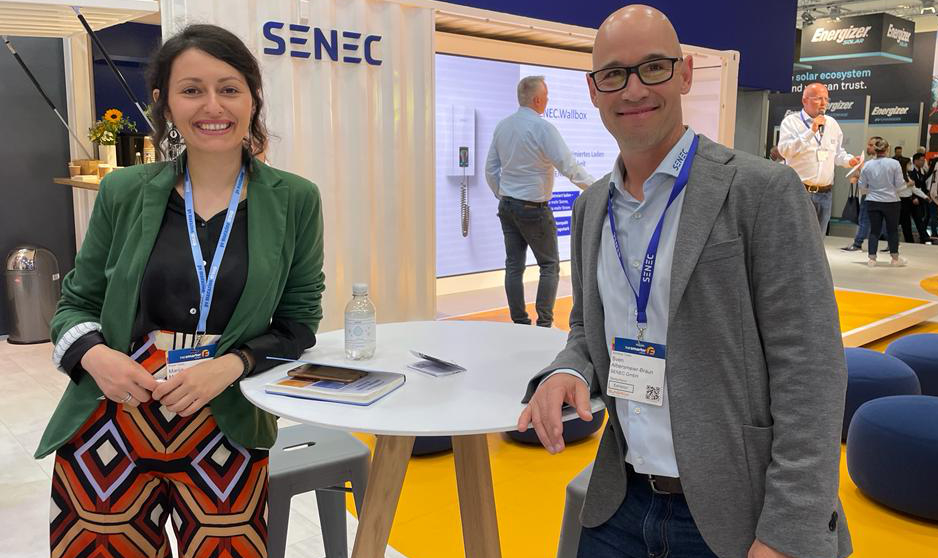
Certification red tape is holding back energy storage
For the REPowerEU plan to deliver more affordable, secure, and sustainable energy, the roll-out of battery storage will play a key role.
However, the lack of uniform certification on a pan-European level is not making things easy for battery manufacturers. According to Sven Albersmeier-Braun, head of international business at Senec, such a standard is the missing link to securing Europe’s energy future.
Lengthy and complicated certification processes are also hindering the roll-out of batteries Down Under. For Senec, the most challenging aspect is requirements which can be changed by regulators, plus the complexity of certification processes. After that, of course, getting onto the Clean Energy Council (CEC) of Australia's list of approved products presents another layer of certification.
To further complicate matters, the Senec executive said, Australia lacks the testing facilities needed to achieve certification for three-phase battery inverters so manufacturers are being redirected to China or back to Europe for testing. There have been reports some European manufacturers have even been de-listed by certification bodies in Australia due to the introduction of new requirements.
For Germany’s Sonnen, keeping product rolling off its local manufacturing lines is also no simple business. According to Nathan Dunn, who heads the company’s Aussie operations, certifications are the biggest pain point and hindrance to its ambitious manufacturing plans in South Australia – and also to bringing new products to market. Late last year, Sonnen launched its Evo battery in Australia but the company has not still managed to secure CEC certification.

Sofar so good...
Our head honcho Eckhart Gouras is getting the crowd warmed up at the booth of Sofarsolar, where the manufacturer is launching its PowerAll product.
If you get along to the stand you can get more details.

'What's still missing is the political will'
There is a strange mix of positivity and negativity on the show floor this year, with big expectations for solar market growth and manufacturing being tempered by the conflict and supply chain constraints that are driving demand.
As Nicolas Chouleur and Ragna Schmidt-Haupt, of consultant Everoze, shared when they swung by pv magazine’s booth, politicians in many regions have barely begun to consider the size of the challenge that securing a reliable, clean energy supply presents.
It is land availability that the pair see as the first big bottleneck, meaning agrivoltaics will need to be developed and rolled out rapidly to offer anything close to a solution to rising global temperatures.

Hats off to REC
Singaporean solar manufacturer REC, recently acquired by Reliance Industries, celebrated its Alpha Pure-R at Intersolar with hats!
A booming presentation engulfed nearby booths and many rounds of applause could be heard. And the biggest cheers? When chief exec Jan Enno Bicker closed his speech with the stirring words: “The bar's open!”
PS: The blog has been informed REC's new Alpha Pure-R module was one of this year's Intersolar Award winners, which were announced on Tuesday.
*This copy was amended on 12/05/22 to indicate REC is based on Singapore, not Norway, as previously reported.

Shipping issues are no trivial affair
In these times of disrupted supply chains and logistical challenges, it’s not easy to secure timely delivery without damage, writes Jonathan Gifford.
The proof of that has been on display at one solar manufacturers’ booth at Intersolar – with a module on display that was a little worse for wear. The panel’s front glass was smashed in two different locations on the single module.
Perhaps the manufacturer should have tapped the services of the PVpallet – which claims to be able to reduce transportation damage with its nifty, specialized module-transportation solution. The company was one of the finalists for the 2022 Intersolar Award – in which the top gongs went to Gamesa Electric, M10 Solar Equipment, and REC. There will be more from the award winners later.
With busted modules and booths still under construction during the show, perhaps logistical solutions deserve a higher profile.
Oh yeah, there's also the fact the Intersolar Award organizers had to go ahead with their ceremony on Tuesday “sans trophies” due to a logistical hiccup…

More Euro news from Enphase
Green Hydrogen Forum gripped by animated debate
At Intersolar 2022's Green Hydrogen Forum, Hydrogen Europe chief executive Jorgo Chatzimarkakis gave an animated, not to say frustrated, response to a Bavarian questioner who thought it inefficient to import green hydrogen from the Middle East, North Africa and elsewhere, implying Bavaria could generate green hydrogen for Bavarians.
“I'm getting angry with this narrative,” said Chatzimarkakis, “it keeps coming up.”
The Hydrogen Europe head pointed out how much more efficient solar electricity produced in the highly irradiated MENA region was than its European equivalent, particularly from Germany. Indeed, it is far more cost-efficient to import the gas, even despite the added transport costs, a point supported by fellow panellist Veronika Grimm, economic theory chair of Friedrich-Alexander-University Erlangen-Nürnberg, who was not as pessimistic as her name might suggest.
“We cannot transition away from fossil fuels without this cost-efficiency,” continued Chatzimarkakis. “I urge you to change this narrative, it's wrong. This small group with the wrong efficiency narrative has been hindering the transition. It can't just be ‘generate hydrogen in Bavaria for Bavarians.' That's not going to help us, it's more efficient to get green hydrogen from Morocco etc.”

QCells unveils new module series, Q.Tron Smart
QCells’ new Q.TRON module series is the company’s first n-type, TOPCon-style solar module, and an interesting addition to this portfolio is the Q.TRON SMART. This module is a smart version of the newly launched Q.TRON-G1+ and boasts an MLPE feature in the form of an embedded power optimizer at the string level.
The MPPT optimization offered by the Maxim Integrated power optimizer offers energy gain by up to 30%, thereby delivering better yield and more revenue for the customer. The Q.TRON SMART also has an easy-to-use module level monitoring system (provided by SunSniffer) to ensure end users enjoy greater control and oversight of their energy consumption.
In combining its new Q.ANTUM NEO cell technology with smart MLPE solutions, Qcells is really raising the bar in efficiency and energy yield with the Q.TRON SMART.

Intersolar Day 2: Women at Sonnen
The pv magazine team passed by the Sonnen booth and spoke to its human resource manager about gender equality.
The company says that half of its employees are women.
CEO Oliver Koch said that the company can still can deliver batteries in a reasonable time frame while also increasing shipments by 70% from last year. This is due to the engagement of the staff, said Koch.
The company transports components in suitcases from China to Germany, where its production facilities are located.
Each person can carry five items on flights, so Sonnen employees often travel back and forth between the countries to secure components, while undergoing quarantine procedures each time they arrive in China.

Vehicle-to-home – a key integration factor
E3/DC, a Hager Energy brand, is one of the bigger suppliers for residential and small commercial storage systems in Germany.
It is presenting new products for charging infrastructure at Intersolar this week.
CEO Andreas Piepenbrink said that the key for the success of solar charging is a working vehicle-to-home solution which allows for the use of car batteries for electricity as well as stationary batteries.
The company is also working on vehicle-to-grid solutions and has already reported about deploying DC charging in homes.
One of its other new products is a wall box that can charge at high power but also down to 1.2 kW.
This is done by automatically switching from a three-phase to a one-phase operation when the charging power needs to be reduced below a certain level.
E3/DC said that it will increase its capacity from 25,000 storage systems to 35,000 units per year.
Given current supply chain issues, the good news is that its partners can still expect steady supplies.
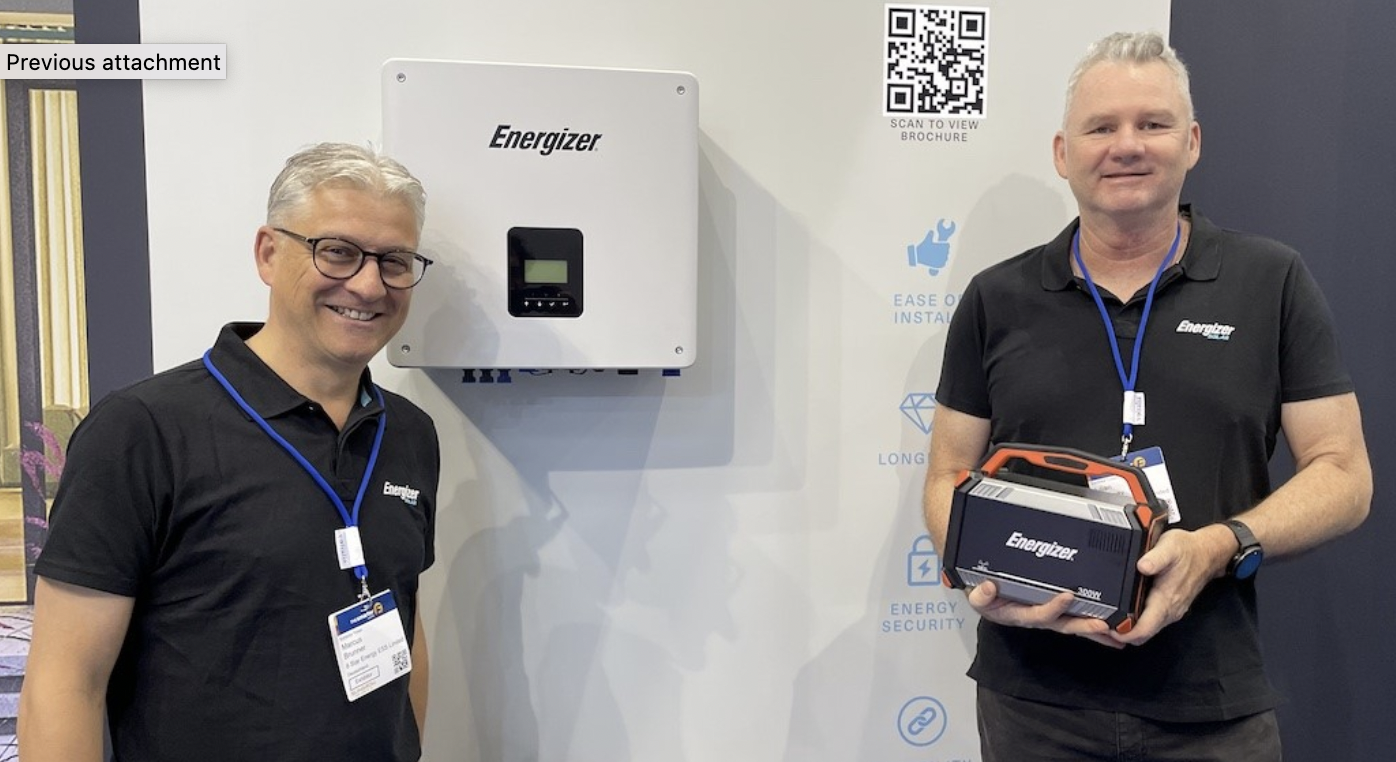
Intersolar Day 2: 8 Star Energy shifting focus from Australia to Europe
At the beginning of the first day of Intersolar, we met Marcus Brunner, general manager Europe for 8 Star Energy, and Julian Sweeney, the company's Australian managing director.
For the next 25 years, the company will be allowed to use the Energizer brand for its batteries, software and energy management.
For those who do not know, non-rechargeable Energizer batteries can be purchased in supermarkets.
Since 2017, 8 Star Energy has operated in Australia, but now it is starting to look at European markets.
Just before Intersolar, the company said that Memodo, a wholesaler, had taken it into its portfolio.
Brunner is well known in the German energy storage scene as he has worked for companies such as Mercedes-Benz Energy and CellCube. He said that customers can expect delivery times of 120 days for the batteries.
If 8 Star Energy can keep this promise, it will offer good value under current market conditions, compared to other storage providers.
Recap from Day 1
On Day 1, we covered everything from shipping problems and full order books, to mounting systems as first responders, Rolls Royce microgrids, and sustainable ambitions.
We also featured a number of new products, including:
- New residential battery from Pylontech
- Jetion presents heterojunction solar module series based on n-type G12 wafers
- Kstar launches all-in-one residential battery inverter solution
- Solis unveils off-grid PV inverter
- Voltec Solar presents bifacial solar module for agrivoltaics
Stay tuned for more live coverage throughout the day!

